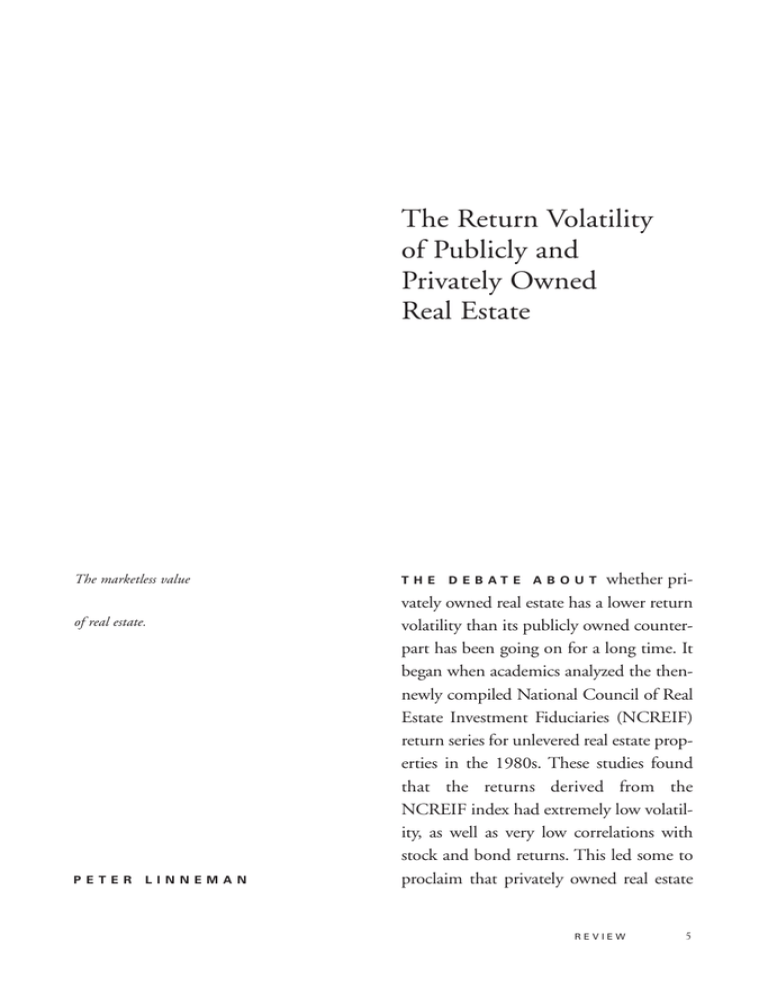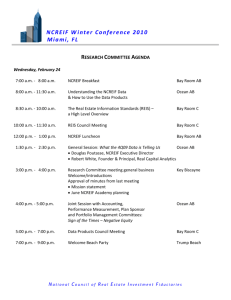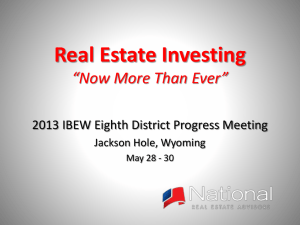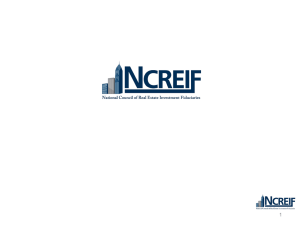The Return Volatility of Publicly and Privately Owned Real Estate
advertisement

The Return Volatility of Publicly and Privately Owned Real Estate The marketless value of real estate. PETER LINNEMAN whether privately owned real estate has a lower return volatility than its publicly owned counterpart has been going on for a long time. It began when academics analyzed the thennewly compiled National Council of Real Estate Investment Fiduciaries (NCREIF) return series for unlevered real estate properties in the 1980s. These studies found that the returns derived from the NCREIF index had extremely low volatility, as well as very low correlations with stock and bond returns. This led some to proclaim that privately owned real estate THE D E B AT E ABOUT REVIEW 5 was a “can’t lose” investment, providing portfolio diversification with almost no return volatility, and average returns not much different from stocks. Efficient investment frontier research seeped into investment practice, which suggested that privately owned real estate should comprise almost 100 percent of an “efficient” portfolio. As the 1990s dawned, investors assumed that high-quality privately owned real estate could never fall substantially in value. But the early 1990s demonstrated that private real estate assets had substantial return volatility, with values eroding by 20 percent to 50 percent during the first half of the decade. As the chairman of Rockefeller Center, one of the nation’s prime core assets in the mid-1990s, I discovered all too well the volatility of private real estate returns. Yet, the NCREIF data failed to reveal significant negative returns. Figure 1: NCREIF Quarterly Returns 6 ZELL/LURIE REAL ESTATE CENTER Instead, the NCREIF total return in 1990 was 2.3 percent, with negative returns registered only in 1991 (-5.6 percent) and 1992 (-4.3 percent). These numbers were in stark contrast to the reality experienced by private property owners. Since the disconnect between NCREIF and the market reality was too great to be explained by differences in property or management quality, savvy observers quickly realized that the NCREIF data was at best problematic, and at worst bogus. The early 1990s witnessed the emergence of major publicy owned REITs. Faced with the complete absence of debt, and plummeting property values, many major private owners of real estate went public in order to recapitalize their properties, paying off maturing debt with IPO proceeds. Overnight, high-quality real estate was exposed to public market scrutiny and pricing, with many of the finest property portfolios trading on the NYSE. These REITs were managed by real estate professionals with expertise equal to, or better than, NCREIF asset managers. Thus, any differential return performance between the NCREIF index and REITs could not be attributed to either product or management quality. A third investment vehicle, real estate private equity funds, evolved to help equitize real estate investments. These nontraded limited partnerships, with seven-toten-year investment lives, use high leverage, frequently own foreign and lesserquality properties, and often pursue development/redevelopment strategies. While the returns for these vehicles are not systematically reported, it is not be surprising that the return history for these higherrisk, lower-quality, value-add investment vehicles substantially diverges from that of either NCREIF or REITs, as their returns do not generally reflect the performance of core U.S. properties. NCREIF VS. NAREIT NCREIF index properties are unlevered, while REIT’s are approximately 50 percent levered. In addition, REITs own both the company’s real estate as well as the profit stream generated by management (net of executive compensation). In contrast, the NCREIF index reflects only returns on properties, with returns to managers captured by the asset management companies. Returns to REITs, as proxied by the National Association of Real Estate Investment Trusts (NAREIT) Equity Index, and NCREIF should be highly correlated, as the key determinant of their returns is the profitability of core quality properties. REITs offer institutional investors a transparent and liquid real estate investment alternative to direct ownership. Since the mid-1990s, funds have flowed into REITs from traditional core real estate managers, causing many core managers to go out of business. Institutional investors were not only disappointed in the performance of real estate versus their expectations, but also angry with managers who hid how badly their investments performed. Yet, based upon studies of NCREIF returns, many researchers, managers, and investors continue to believe that privately owned real estate has almost no correlation with the returns of REITs, stocks, or bonds. For example, from the first quarter of 1990 through the first quarter of 2004, the correlation of NCREIF’s return with that of NAREIT was -0.04, while with S&P 500 it was 0.01, and with long bonds -0.10. In addition, the standard deviation of quarterly returns for this same period was 3.4 percent for NCREIF, versus 10.5 percent for NAREIT, 11.3 percent for S&P 500, and 6.9 percent for long bonds. REVIEW 7 As a result, many observers argue that institutional investors should own real estate both publicly and privately, with publicly owned real estate providing liquidity, and privately owned real estate providing return stability and diversification. But these results cannot be correct, as buildings are inanimate objects, which do not know whether they are publicly or privately owned. Further, most core properties are managed by high-quality managers, whether the properties are publicly or privately owned. Therefore, large return discrepancies between public and private real estate ownership are not theoretically credible. Of course, minor return differences between public and private real estate can arise due to the valuation of management teams (which is a Figure 2: Annual Total Returns 8 ZELL/LURIE REAL ESTATE CENTER part of a REIT’s valuation), or as a result of leverage, or because short-term capital movements are insufficient to arbitrage public versus private pricing. However, the return differences between NCREIF and NAREIT are not small, temporary, or occasional. In five of the past 14 years, the annual returns for NCREIF and NAREIT are of opposite signs. Moreover, the average absolute difference in the annual returns of these series is a staggering 1715 basis points, with this difference being fewer than 600 basis points in only two years. For example, 1998 REIT returns were shocked by the Russian ruble crisis, yielding a -17.5 percent return, while the NCREIF return was 16.2 percent, a gap of 3370 basis points! Figure 3: Return Disparity between NAREIT and NCREIF (Basis Points) W H AT ’ S GOING ON? The best research on the differences between NCREIF and NAREIT returns has been conducted by Joe Gyourko, first in a paper with Don Keim, and more recently in a paper in the Wharton Real Estate Review. He finds that NCREIF returns are predictable based upon historic REIT returns. Specifically, today’s REIT returns foretell the NCREIF returns that will be registered roughly 18 months from now. As has been stated before, since buildings are inanimate, and since their quality of management is roughly similar, this relationship cannot be due to significant differences in property level cash flows, risk profiles, or management. One need not be a believer in perfectly efficient markets to feel that it is inconceivable that capital markets so inefficiently value public versus private real estate cash streams. While anomalies can exist, they will be arbitraged, particularly given the large number of opportunity funds with the broad mandate to simply generate risk-adjusted real estate returns. If return differences are consistently as divergent as these series indicate, there should be no shortage of “smart money” to arbitrage the differences. In addition, REITs’ property acquisitions and dispositions would arbitrage large differences in “Wall Street vs. Main Street” values. Yet, during the past 14 years, in spite of the extraordinary differences in NCREIF and NAREIT returns, few REITs were taken private, very few major positions in REITs were taken by opportunity funds, and almost no REITs liquidated their portfolios. The primary reason why large return discrepancies between NCREIF and NAREIT exist is simple: the data are REVIEW 9 wrong. This was vividly demonstrated during the Russian ruble crisis, when REITs fared terribly, while NCREIF registered returns well above average. Yet almost no public to private arbitrage took place, even though the return data indicate that such activity would have been highly profitable. No opportunity funds took advantage of the option suggested by the data. Nor did entrepreneurial REIT operators see an opportunity to go private. Instead, the market clearly believed that there was no significant return differential between public and private real estate. Like Sherlock Holmes’ famous “dog that didn’t bark,” the market’s silence demonstrated that the return gap is fiction rather than reality. VA L UAT I O N ISSUES NAREIT pricing and returns reflect market pricing by third parties investing in publicly traded securities, and thus have no notable measurement error. It is also an investable index, with several index funds readily available for investors. In contrast, the NCREIF index is neither investable nor a market-priced index. Specifically, it is impossible to create a portfolio that contains the NCREIF properties, and NCREIF property prices are very rarely set by third-party investors. Instead, they are established by appraisals. 10 ZELL/LURIE REAL ESTATE CENTER Many have noted the so-called appraisal lag in valuing NCREIF properties. However, the NCREIF return measurement problem is much deeper, as most observers fail to appreciate how the appraisal process, even when well done, generates meaningless valuations for evaluating return volatility and correlations. In fact, the appraisal process guarantees that NCREIF’s appraisal-driven returns will have very low volatility. Since the appraisal process, rather than privatemarket real estate pricing, creates nearzero volatility in measured returns, nearzero return correlations with REITs, stocks, and bonds are no surprise, as these assets have considerable return volatility. Specifically, if the returns for stocks, bonds, and publicly traded real estate are essentially random walks reflecting relatively efficient market pricing, NCREIF’s near-zero appraisalinduced volatility will necessarily show little return correlation. How does the use of appraised property values produce this result? The vast majority of NCREIF properties have a value appraisal only in the fourth quarter of each year. This contrasts dramatically with private property markets, where properties are constantly valued (though not appraised) by owners. Opportunity funds, entrepreneurial owners, and highwealth families constantly evaluate their property values. Anyone who has worked with these owners knows that, over the course of a year, the values of privately owned properties rise and fall, depending on leasing, market sentiments, rumors about new developments, macroeconomic hopes and fears, and capital market animal instincts. Many private owners exploit these value movements by either selling or refinancing their properties at opportune times, or by holding their properties while waiting for better market pricing. This is the reality of private markets. Companies such as Eastdil, Secured Capital, and Goldman Sachs make their livings from the volatility of private real estate markets. Consider what happens to a real estate return series if the value of a core property is recorded only on the last day of each year. Since a core property’s Net Operating Income (NOI) generally varies relatively little throughout the year, so too will the measured return if the property price remains unchanged for four quarters. For example, if the property has a quarterly NOI growth rate of 1 percent (4.06 percent annual rate), and an 8 percent initial cap rate, the registered quarterly returns absent quarter-to-quarter price changes over the four quarters of the year are 2.02 percent, 2.04 percent, 2.06 percent, and 2.08 percent, respectively. Hence, for NCREIF’s large pool of core assets, it is almost impossible to have much quarter-to-quarter return volatility without accurately measuring quarterly value changes. But if the preponderance of core properties is appraised only in the fourth quarter, the return registered for NCREIF is by definition basically the same in the fourth, first, second, and third quarters, as NOI does not change appreciably quarter-by-quarter. The fact that the recorded returns are basically the same over a four-quarter period provides no information about whether the actual quarterly returns were the same, and merely reflects that no attempt was made to determine whether asset prices changed quarter-to-quarter. This is the first source of NCREIF’s return smoothing. Imagine what would happen if NAREIT quarterly returns were measured simply by dividing the quarterly dividend by the fourth quarter cap rate. Since NAREIT dividends change relatively little quarter-to-quarter, this approach would record little REIT return volatility. Gyourko’s research notes that during the first three quarters of the year, NCREIF returns register little volatility for private real estate. But savvy private owners know this is not the case. A point of reference is provided by (incorrectly) calculating NAREIT returns as the quarterly dividend plus appreciation, divided by the closing year-end stock price. Figure 4 reveals that this exercise notably reduces the volatility of NAREIT’s quarterly returns. REVIEW 11 Figure 4: NAREIT Quarterly Returns In fact, the standard deviation of NAREIT quarterly returns falls from 10.5 percent for actual NAREIT returns to 7.0 percent when this method is employed. Thus, if investors want lower REIT return volatility, and to look more like NCREIF’s, they should only look at the REIT stock prices on the last day of each year! QUADRUPLE SMOOTHING The NCREIF measurement error story does not end here, as NCREIF’s fourthquarter value generally reflects appraised— as opposed to market—property prices. To see how the appraisal process even further undercuts return measurement efforts, one must understand the appraisal process. 12 ZELL/LURIE REAL ESTATE CENTER When an “unbiased” appraiser (they may, like unicorns, exist somewhere) is engaged, their methodology for a core, stabilized property is to divide “stabilized” NOI (a second smoothing) by the cap rate of recent transactions for comparable properties. The period for which the appraiser seeks comparable sales transactions is typically 24 months. Over this 24-month period, the appraiser will generally find five to eight comparable property sales. The cap rate selected by the appraiser is usually the mean (or sometimes median) of the cap rates for these transactions. Rarely do appraisers give more weight to more recent transactions, or evaluate cap rate trends. Thus, although each comparable property sold at a specific cap rate, at a specific time, the appraisal cap rate is an average (a third source of smoothing), which eliminates the high and low valuations that existed in the market; that is, it eliminates pricing volatility. The appraiser’s rationale for cap rate averaging is that the market conditions that existed when those properties were sold are better or worse than those that exist “in more typical markets.” Further, the appraisal for a property this year will generally re-use approximately half of the comparable sales transactions of the previous year’s appraisal. Thus, this year’s cap rate is mechanically linked to last year’s cap rate, introducing a fourth source of NCREIF return smoothing. Note that the appraisal methodology adopts the position that while higher and lower cap rates than average existed, they are of no relevance to a property’s appraised value. In fact, every property was transacted at a cap rate higher or lower than the average, indicative of thencurrent market conditions. Stated bluntly, the appraisal process eliminates—not reveals—the truth about how properties are priced in private markets. In effect, the appraised value, far from being the market value, is, in effect, a marketless value. That is, it is a value net of the vagaries of the market. Tellingly, no property is ever bought or sold at the appraiser’s cap rate. Yet many researchers use the NCREIF return as if the cap rates used to value its properties reflect private property market prices. But by design, this is absolutely not the case. The nature of the appraisal process means that even in the fourth quarter, the registered NCREIF value fails to reflect the prevailing market pricing, reflecting instead the average of market conditions that prevailed over the preceding two years. In fact, what NCREIF records as “today’s cap rate” is actually the mean cap rate about 12 months earlier; that is, at the midpoint of the appraiser’s time period. Hence, NCREIF fourth-quarter valuations effectively reflect “stabilized” NOI divided by the average cap rate a year ago. Quadruple-smoothed, with a lag. This appraisal smoothing and lag not only reduces measured return volatility, but also almost necessarily eliminates any correlation with market return series. This is because if actual returns follow a random walk, inducing a one-year lag, the lagged series is uncorrelated with the original series, as the lag wipes out all correlation with all random series. Since stock, bond, and REIT returns have been shown to basically follow random walks, even if true private real estate returns were highly correlated with these series, the NCREIF appraisal lag would wipe out the correlation. The impact of lagging is vividly demonstrated by the fact that the correlation between quarterly S&P returns and the eight-quarter moving average of S&P returns is a mere 0.16 from 1990 through the first quarter of 2004. Thus, a series, which by definition REVIEW 13 is perfectly correlated with itself, is basically uncorrelated with a NCREIF-like lagged version of itself. The fact is that while NAREIT returns reflect actual returns for an investable public real estate portfolio, NCREIF returns measure nothing remotely like actual returns for a core private portfolio. The 12-month valuation lag is accentuated over the subsequent three quarters, as NCREIF’s appraised values are generally not changed during these quarters. Thus, the cap rate used in the appraisals is initially four quarters out of date, falling to five, six, and seven quarters over the next three quarters. As the property values are reappraised in the fourth quarter, the lag once again reverts to four quarters, and the process repeats. It is hardly surprising that Gyourko’s research consistently finds a roughly 18-month statistical relationship between REIT returns (actual market pricing) and NCREIF’s lagged returns. IT’S O N LY REAL E S TAT E To see how quadruple-smoothing-and-alag mechanically affects measured returns, we calculate a variety of incorrectly measured quarterly REIT returns. First, for each quarter, the quarterly return is calculated as the sum of the actual NAREIT dividend plus percentage price appreciation, where price is defined as the moving 14 ZELL/LURIE REAL ESTATE CENTER average NAREIT price for the preceding eight quarters. This smoothing and lagging reduces the standard deviation of NAREIT quarterly returns from 10.5 percent for actual returns, to 4.9 percent. Conducting the same analysis with NAREIT price calculated as the NAREIT dividend divided by the eight-quarter NAREIT moving average cap rate results in an estimated REIT quarterly return standard deviation of 5.7 percent. We also recalculate quarterly NAREIT returns, where for the fourth quarter the return is the actual NAREIT dividend divided by the moving average NAREIT cap rate for the preceding eight quarters, plus the percentage increase in that price over the similarly calculated price of a year earlier, where for the first, second, and third quarters there is no price change. The standard deviation of NAREIT quarterly returns for this approach is 7.7 percent. How do these results compare to NCREIF? Recall that NCREIF is unlevered, while NAREIT is roughly 50 percent levered. To adjust for the different leverage, we calculated quarterly returns for a 50 percent leveraged NCREIF, at an interest rate of three-year Treasury plus 150 basis points. The standard deviation of this levered NCREIF series is 5.2 percent (versus 3.4 percent for unlevered NCREIF). This levered NCREIF return volatility compares to 10.5 percent for actual NAREIT, and 5.7 percent and 7.7 percent for the smoothed NAREIT series. Plus, one must remember that the use of actual, rather than “stabilized,” NAREIT dividends in these calculations makes NAREIT returns more volatile than levered NCREIF, which uses “stabilized” NOI. Thus, when compared on an apples-to-apples basis, the return volatilities of NCREIF are NAREIT are basically the same. The correlation coefficients of the alternative quarterly return series are displayed in Figure 5. Note that smoothed and lagged NAREIT returns, like both NCREIF and unlevered NCREIF, show little correlation with the S&P 500 or long bonds. This is because the non-volatility induced by quadruple-smoothing-and-alag correlates to almost nothing. In contrast, the mean returns for the various NAREIT returns are only slightly altered by these smoothing calculations, because the time shifting only slightly alters the time period over which returns are effec- tively measured. Further, smoothed NAREIT returns have a much higher (though still low) correlation with NCREIF. The best series to measure real estate returns is neither NCREIF nor the smoothed NAREIT series, but rather the actual REIT return series. This is because mark-to-market, contemporaneous, arm’slength, non-smoothed pricing is the reality of both public and private real estate. The truth is that modestly leveraged core real estate has a low correlation with stocks and bonds, but displays notable return volatility, though somewhat less so than stocks. No one involved in private real estate markets will find these results surprising. After all, real estate ownership of core assets incorporates many of the dimensions of high-quality bonds, with superior residual value protection because it is a real (rather than nominal) asset. The result is that non-residential real estate has less cash Figure 5: Quarterly Return Correlation Coefficients Quarterly Return Correlation Coefficients Smoothed NAREIT1 -.16 Acutal NAREIT Smoothed NAREIT 1 Smoothed NAREIT2 -.21 .55 Smoothed NAREIT2 Unlevered NCREIF Levered NCREIF Unlevered NCREIF -.05 Levered NCREIF -.05 S&P 500 Long Bonds .40 .08 .14 .15 -.04 -.10 .14 .14 .12 -.24 .99 .01 -.10 .01 -.10 S&P 500 -.09 1 Based upon eight-quarter moving average NAREIT price. 2 Based upon eight-quarter moving average NAREIT price, with estimated price unchanged for four consecutive quarters. REVIEW 15 stream volatility than the equity and debt claims on its tenants, since in good times, tenants expand their space demand more slowly than their profits increase, while in bad times the reverse is true. In addition, the supply and demand fundamentals of real estate follow unique patterns, further diminishing the return correlations with other assets. Similarly, residential real estate follows its own time patterns, as even in poor economic times, population increases and absorption generally occurs, although at a slower rate. Also, supply and demand patterns for these properties move differently from other asset categories. D AY- T O - D AY R E I T VO L AT I L I T Y As is the case with a publicly traded security of any company, one is struck by the fact that in any one-hour or one-day trading period, the price of a REIT (or any) stock can go up or down by several percentage points, for no apparent reason. It is true that privately owned real estate does not have such minute-to-minute, hour-tohour, or day-to-day price volatility, as deals are not struck in private markets on such an instantaneous basis. The presence of such price volatility for REITs means investment opportunities are available via the public ownership of private real estate that are not present with private owner- 16 ZELL/LURIE REAL ESTATE CENTER ship. Specifically, this volatility allows institutional owners of REITs to take advantage of momentary mispricings of their stocks by selling or shorting when prices are “too high,” and incrementally buying when prices are “too low.” Such trading provides an additional margin for well-capitalized institutional investors to exploit temporary pricing anomalies. Of course, just as is the case for private real estate, if one is convinced that REIT prices are too high, one can sell one’s entire position. Similarly, if one believes that prices are too low, one can hold stocks until prices rise. Publicly owned real estate allows investors to incrementally alter their investment position when they believe pricing is too low or too high. In fact, aggressive institutional investors may go so far as to short assets when they believe prices are too high. Thus, far from being a negative aspect of public real estate investment, the presence of micro price volatility can only benefit well-capitalized longterm investors. At worst, the institutional investor can simply ignore such pricing variability, and simply trade out of their holdings on last day of each quarter, in which case they realize NAREIT returns. W H AT ’ S IT ALL MEAN? There is no magical potion in the private ownership of core real estate that elimi- nates return volatility and correlation with other assets. The fact that investors continue to believe this is the case reflects either a fundamental misunderstanding of the NCREIF data, or purposeful ignorance about the realities of real estate markets. The truth is that high-quality, stabilized real estate should be a major part of institutional investors’ portfolios, and that public ownership provides the same longterm return patterns as private ownership, with the enhanced advantages of exploiting temporary mispricings and liquidity. Core real estate provides solid longterm returns, somewhat lower volatility relative to stocks, and relatively modest correlation with the returns on other assets. However, the purported advantages of private core real estate ownership are a mirage. What matters are the quality of the property and the ability of the manager to execute a viable operating strategy, whether public or private. Private core real estate ownership for many institutions is a narcotic that creates the “comfortably numb” illusion of nonvolatility in a harsh and demanding markto-market world. It is one of the few remaining assets where you can pretend that your assets have not changed in price, even when they have. Hopefully, such illusions will soon be a thing of the past. REVIEW 17






